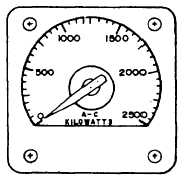Figure 11-17.—An ac ammeter.
Figure 11-18.—Frequency meter.
AMMETERS
Ammeters are used to measure the amount of
current passing through a conductor (fig. 11-17).
Different types of ammeters are used to measure either
ac or dc. Ammeters that are designed specifically to
indicate ac will also measure dc, but with a lower degree
of accuracy.
Ammeters must be connected in series with the
circuit to be measured. For this reason, installed
ammeters are constructed so that they do not handle the
current that passes through the conductor being
measured. Since ammeters cannot handle the high
switchboard current, the switchboard ammeters operate
through current transformers. This arrangement isolates
the instruments from the line potential. In its secondary,
the current transformer produces a definite fraction of
the primary current. This arrangement makes it possible
for you to measure large amounts of current with a small
ammeter.
CAUTION
The secondary of a current transformer
contains a dangerous voltage. Never work
around or on current transformers without
taking proper safety precautions.
FREQUENCY METERS
Frequency meters (fig. 11-18) measure cycles per
rate of ac. The range of frequency meters found on gas
turbine ships is between 55 hertz (Hz) and 65 Hz.
Frequency of the ac used on ships rarely varies below
57 Hz and seldom exceeds 62 Hz. A frequency meter
may have a transducer that converts the input frequency
to an equivalent dc output. The transducer is a static
device that has two separately tuned series-resonant
circuits, which feed a full-wave bridge rectifier. A
change in frequency causes a change in the balance of
the bridge. This causes a change in the dc output voltage.
KILOWATT METERS
Matter is measured by computing values of current,
voltage, and the power factor. The kilowatt meters (fig.
11-19) used on ships automatically take these values into
account when they are measuring kilowatts (kW)
produced by a generator. Kilowatt meters are connected
to both current and potential transformers so they can
measure line current and voltage. Since each type of
generator is rated differently, the scale is different on
each class of ship.
The amount of power produced by a generator is
measured in kilowatts. Therefore, when balancing the
electrical load on two or more generators, you should
make sure the kW is matched. Loss of the kW load is
the first indication of a failing generator. For example,
if two generators are in parallel, and one of the two units
is failing, you should compare the Kw reading.
Normally, the generator with the lowest kW would be
Figure 11-19.—Kilowatt meter.
11-10





